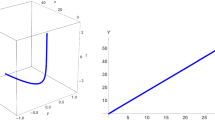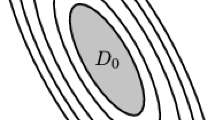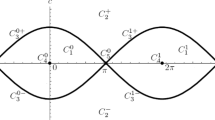Abstract
J-trajectories are arc-length-parameterized curves in almost Hermitian manifolds, which satisfy the equation \(\nabla _{{\dot{\gamma }}}{\dot{\gamma }}=q J {\dot{\gamma }}\). In this paper, J-trajectories in the solvable Lie group \(\textrm{Sol}_1^4\) are investigated. J-trajectories of osculating order 2 and 3, homogeneous J-trajectories and J-trajectories in subspace\(\textrm{Nil}_3\) are examined.
Similar content being viewed by others
References
Andrada, A., Origlia, M.: Locally conformally Kähler structures on unimodular Lie groups. Geom. Dedicata 179, 197–216 (2015)
Andrada, A., Barberis, M.L., Dotti, I.G., Ovando, G.P.: Product structures on four dimensional solvable Lie algebras. Homol. Homot. Appl. 7(1), 9–37 (2005)
Angella, D., Origlia, M.: Locally conformally Kähler structures on four-dimensional solvable Lie algebras. Complex Manifolds 7, 1–35 (2020)
Angella, D., Bazzoni, G., Parton, M.: Structure of locally conformally symplectic Lie algebras and solvmanifolds. Ann. Sc. Norm. Super. Pisa, Cl. Sci. 20(5), 373–411 (2020). arXiv:1704.01197v2 [math.DG]
Anosov, D.V., Sinaĭ, Ja.G.: Certain smooth ergodic systems. Russ. Math. Surv. 22(5), 103–167 (1967)
Apostolov, V., Calderbank, D., Gauduchon, P.: Hamiltonian \(2\)-forms in Kähler geometry. I. General theory. J. Differ. Geom. 73(3), 359–412 (2006)
Arnol’d, V.I.: First steps in symplectic topology. Uspekhi Mat. Nauk. 41(6), 3–18 (1986). English translation: Russ. Math. Surv. 41, 1–21 (1986)
Arnol’d, V.I.: Some remarks on flows of line elements and frames. Sov. Math. Dokl. 2, 562–564 (1961)
Arvanitoyeorgos, A., Souris, N.P.: Motion of charged particle in a class of homogeneous spaces. Math. Phys. Anal. Geom. 23, 22 (2020)
Ateş, O., Munteanu, M.I., Nistor, A.I.: Periodic \(J\)-trajectories on \(\mathbb{R} \times \mathbb{S} ^3\). J. Geom. Phys. 133, 141–152 (2018)
Ateş, O., Munteanu, M.I., Nistor, A.I.: Dynamics on \(\mathbb{S} ^3\) and the Hopf fibration. Appl. Math. Comput. 347, 429–441 (2019)
Barros, M., Romero, A.: Magnetic vortices. EPL 77(3), 34002 (2007)
Barros, M., Cabrerizo, J.L., Fernández, M., Romero, A.: Magnetic vortex filament flows. J. Math. Phys. 488, 082904 (2007)
Belgun, F.A.: On the metric structure of non-Kähler complex surfaces. Math. Ann. 317, 1–40 (2000)
Biggs, R., Remsing, C.C.: On the classification of real four-dimensional Lie groups. J. Lie Theory 26(4), 1001–1035 (2016)
Bolsinov, A., Morales-Ruiz, J., Zung, N.T.: Geometry and Dynamics of Integrable Systems. Advanced Courses in Mathematics, CRM Barcelona. Birkhäuser, Basel (2016)
Bolsinov, A.V., Matveev, V.S., Rosemann, S.: Local normal forms for c-projectively equivalent metrics and proof of the Yano-Obata conjecture in arbitrary signature. Proof of the projective Lichnerowicz conjecture for Lorentzian metrics. Ann. Sci. Ecole Normale Super. 6(54), 1465–1540 (2021)
Cabrerizo, J.L.: Magnetic fields in 2D and 3D sphere. J. Nonlinear Math. Phys. 20(3), 440–450 (2013)
Dragomir, S., Ornea, L.: Locally Conformal Kähler Geometry. Progress in Math. vol. 155. Birkhäuser (1998)
Erjavec, Z., Inoguchi, J.: On magnetic curves in almost cosymplectic Sol space. Results Math. 75, 113 (2020)
Erjavec, Z., Inoguchi, J.: Magnetic curves in \(\mathbb{H} ^3\times \mathbb{R} \). J. Korean Math. Soc. 58(6), 1501–1511 (2021)
Erjavec, Z., Inoguchi, J.: \(J\)-trajectories in 4-dimensional solvable Lie groups \(\rm Sol _0^4\). Math. Phys. Anal. Geom. 25, 8 (2022)
Esen, O., de León, M., Sardón, C., Zajşc, M.: Hamilton-Jacobi formalism on locally conformally symplectic manifolds. J. Math. Phys. 62(3), 033506 (2021)
Fassò, F., Sansonetto, N.: Nearly-integrable almost-symplectic Hamiltonian systems. arXiv:1601.00465 (2016)
Fassò, F., Sansonetto, N.: Integrable almost-symplectic Hamiltonian systems. J. Math. Phys. 48, 092902 (2007)
Filipkiewicz, R.: Four dimensional geometries, Ph.D. thesis. University of Warwick (1983)
Ginzburg, V. L.: A charge in a magnetic field: Arnold’s problems 1981–9, 1982-24, 1984–4, 1994–14, 1994–35, 1996–17, and 1996–18. In: Arnold, V.I. (ed.) Arnold’s problems. Springer-Verlag and Physis, pp. 395–401 (2004)
Hasegawa, K., Kamishima, Y.: Locally conformally Kähler structures on homogeneous spaces. In: Geometry and Analysis on Manifolds. Progr. Math., vol. 308. Birkhäuser/Springer, pp. 353–372 (2015)
Hasegawa, K.: Complex and Kähler structures on compact solvmanifolds. J. Symplectic Geom. 3, 749–767 (2005)
Hashinaga, T.: On the minimality of the corresponding submanifolds to four-dimensional solvsolitons. Hiroshima Math. J. 44(2), 173–191 (2014)
Hillman, J.A.: Geometries and infrasolvmanifolds in dimension \(4\). Geom. Dedicata 129, 57–72 (2007)
Hosseinzadeh, V., Nozari, K.: Covariant statistical mechanics of non-Hamiltonian systems. Int. J. Geom. Methods Mod. Phys. 15(02), 1850017 (2018)
Inoguchi, J.: \(J\)-trajectories in locally conformal Kähler manifolds with parallel anti-Lee field. Int. Electron. J. Geom. 13(2), 30–44 (2020)
Inoguchi, J., Lee, J.-E.: \(J\)-trajectories in Vaisman manifolds. Differ. Geom. Appl. 82, 101882 (2022)
Inoguchi, J., Munteanu, M.I.: Periodic magnetic curves on Berger spheres. Tohoku Math. J. 69(1), 113–128 (2017)
Inoguchi, J., Munteanu, M.I., Nistor, A.I.: Magnetic curves on quasi-Sasakian 3-manifolds. Anal. Math. Phys. 9(1), 43–61 (2019)
Inoue, M.: On surfaces of class \(\rm VII _0\). Invent. Math. 24, 269–310 (1974)
Jo, J.H., Lee, J.B.: Nielsen type numbers and homotopy minimal periods for maps on solvmanifolds with \(\rm Sol _1^4\)-geometry. Fixed Point Theory Appl. 175, 1–15 (2015)
Kamishima, Y.: Note on locally conformal Kähler surfaces. Geom. Dedicata 84, 115–124 (2001)
Kiyohara, K., Topalov, P.: On Liouville integrability of \(h\)-projectively equivalent Kähler metrics. Proc. Am. Math. Soc. 139(1), 231–242 (2010)
Lauret, J.: Ricci soliton solvmanifolds. J. Reine Angew. Math. 650, 1–21 (2011)
Lee, K.B., Thuong, S.: Infra-solvmanifolds of \(\rm Sol _1^4\). J. Korean Math. Soc. 52, 1209–1251 (2015)
MacCallum, M.A.H.: On the classification of the real four-dimensional Lie algebras. In: Harvey, A. (ed.) On Einstein’s Path, pp. 299–317. Springer, New York (1999)
Matveev, V.S., Rosemann, S.: Proof of the Yano-Obata conjecture for \(h\)-projective transformations. J. Differ. Geom. 92, 221–261 (2012)
Munteanu, M.I., Nistor, A.I.: Magnetic curves in the generalized Heisenberg group. Nonlinear Anal. 214, 112571 (2021)
Ornea, L.: Locally conformally Kähler manifolds. A selection of results. Lecture notes of Seminario Interdisciplinare di Matematica, 4, 121–152 (2005) arXiv:math/0411503v2 [math.DG]
Otsuki, T., Tashiro, Y.: On curves in Kaehlerian spaces. Math. J. Okayama Univ. 4, 57–78 (1954)
Ovando, G.: Invariant complex structures on solvable real Lie groups. Manuscr. Math. 103, 19–30 (2000)
Ovando, G.: Complex, symplectic and Kähler structures on four dimensional Lie groups. Rev. Un. Mat. Argentina 45(2), 55–67 (2004)
Snow, J.E.: Invariant complex structures on four-dimensional solvable real Lie groups. Manuscr. Math. 66, 397–412 (1990)
Song, C., Sun, X., Wang, Y.: Geometric solitons of Hamiltonian flows on manifolds. J. Math. Phys. 54(12), 121505 (2013)
Thuong, S.V.: Metrics on 4-dimensional unimodular Lie groups. Ann. Glob. Anal. Geom. 51, 109–128 (2017)
Thuong, S.V.: Classification of closed manifolds with \(\rm Sol _1^4\)-geometry. Geom. Dedicata 199, 373–397 (2019)
Tomter, P.: Constant mean curvature surfaces in the Heisenberg group. Proc. Sympos. Pure Math. 54, 485–495 (1993)
Tricerri, F.: Some examples of locally conformal Kähler manifolds. Rend. Sem. Mat. Univ. Politec. Torino 40, 81–92 (1982)
Vaisman, I.: On locally conformal almost Kähler manifolds. Isr. J. Math. 24, 338–351 (1976)
Vaisman, I.: Non-Kähler metrics on geometric complex surfaces. Rend. Sem. Mat. Univ. Politec. Trino 45(3), 117–123 (1987)
Vaisman, I.: Hamiltonian vector fields on almost symplectic manifolds. J. Math. Phys. 54, 092902 (2013)
Wall, C.T.C.: Geometries and geometric structures in real dimension 4 and complex dimension 2. In: Geometry and Topology. Lecture Notes in Math., vol. 1167, pp. 268–292 (1985)
Wall, C.T.C.: Geometric structures on compact complex analytic surfaces. Topology 25(2), 119–153 (1986)
Zung, N.T.: A conceptual approach to the problem of action-angle variables. Arch. Ration. Mech. Anal. 229, 789–833 (2018) arXiv:1706.08859v2 [math.DS]
Acknowledgements
We would like to thank the anonymous reviewer for careful reading of our manuscript and for the constructive comments and suggestions for improvement of this paper.
Funding
The second author is partially supported by JSPS Kakenhi JP15K04834 JP19K03461, JP23K03081.
Author information
Authors and Affiliations
Corresponding author
Ethics declarations
Conflict of interest
The authors declare no potential conflict of interests.
Additional information
Communicated by Anthony Bloch.
Publisher's Note
Springer Nature remains neutral with regard to jurisdictional claims in published maps and institutional affiliations.
Appendices
Appendix A: Curves in LCK Manifolds
Definition 3
If \(\gamma \) is a curve in a Riemannian manifold M, parametrized by arc length s, we say that \(\gamma \) is a Frenet curve of osculating order r if there exist orthonormal vector fields \(E_1\), \(E_2, \ldots ,E_r\) along \(\gamma \) such that
where \(\kappa _1, \kappa _2, \ldots , \kappa _{r-1}\) are positive \(C^\infty \) functions of s. The function \(\kappa _j\) is called the j-th curvature of \(\gamma \).
A geodesic is regarded as a Frenet curve of osculating order 1. A circle is defined as a Frenet curve of osculating order 2 with constant \(\kappa _1\). A helix of order r is a Frenet curve of osculating order r, such that all the curvatures \(\kappa _1,\kappa _2, \ldots , \kappa _{r-1}\) are constant.
For Frenet curves in almost Hermitian manifolds, we recall the following notion:
Definition 4
Let \(\gamma (s)\) be a Frenet curve of osculating order \(r>0\) in an almost Hermitian manifold (M, J, g). The complex torsions \(\tau _{ij}\) (\(1\le i<j\le r\)) are smooth functions along \(\gamma \) defined by \(\tau _{ij}=g(E_{i},JE_{j})\). A helix of order r in (M, J, g) is said to be a holomorphic helix of order r if all complex torsions are constant. In particular holomorphic helices of order 2 are called holomorphic circles.
Now let \(\gamma (s)\) be a normal J-trajectory of charge q in an LCK surface \(M=(M,J,g)\). First we observe that the first curvature \(\kappa _1\) is constant \(\vert q \vert \) by comparing the J-trajectory equation and the Frenet formulas (17). The Frenet formulas imply that the first normal vector field \(E_2\) is given by \(E_2=\pm J{\dot{\gamma }}\). Let \(\varepsilon =q/ \vert q \vert \), then we have \(E_2=\varepsilon \,J{\dot{\gamma }}\) and \(\kappa _1=\varepsilon q>0\).
Remark A.1
If a Frenet curve \(\gamma \) in an almost Hermitian manifold (M, J, g) is a J-trajectory, then
If M is a Kähler manifold, then every J-trajectory is a holomorphic circle. This fact is closely related to the so-called Yano-Obata conjecture. In the complex projective space \(\mathbb {C}P^n(c)\) of constant holomorphic sectional curvature \(c>0\), every h-planar curve lies in a complex projective line. Moreover, the Lie group of h-projective transformations is strictly larger than holomorphic isometry group. In Matveev and Rosemann (2012) and Bolsinov et al. (2021) is proved that the identity components of h-projective transformations on a compact Kähler manifold (M, J, g) of complex dimension \(>1\) coincides with that of holomorphic isometry group unless M is isomorphic to \(\mathbb {C}P^n(c)\). On the other hand, in Kiyohara and Topalov (2010) is showed that under suitable non-degeneracy condition, compact Kähler manifolds admitting h-projectively equivalent metrics are biholomorphically equivalent to complex projective space.
by using the formula (2) and Frenet equations, we have
Equation (18) implies that if M is Kähler, then \(\kappa _2=0\). This conclusion is consistent with the fact “every J-trajectory of a Kähler manifold is a holomorphic circle" mentioned in Remark A.1. In addition, we notice that \(\kappa _2=0\) along \(\gamma \) if and only if \((\nabla _{{\dot{\gamma }}}J){\dot{\gamma }}=0\) holds. Note that (18) is rewritten as
Equation (19) implies that every J-trajectory satisfies \(\kappa _2\tau _{13}=\kappa _2\tau _{23}=0\). Moreover from (19) we notice that \(\gamma \) is of order 2 if and only if
along \(\gamma \). In other words, \(\gamma \) is of osculating order 2 if and only of \(A_\gamma \) lies in the osculating plane of \(\gamma \).
Proposition A.1
(Erjavec and Inoguchi 2022) Let \(\gamma \) be a non-geodesic J-trajectory with strength \(q\not =0\) parametrized by arc length in an LCK manifold M whose anti-Lee field has constant length. Then, the first and the second curvatures of \(\gamma \) are given by:
In particular, \(\kappa _1\) is constant.
Proposition A.2
(Erjavec and Inoguchi 2022) Let \(\gamma \) be a non-geodesic J-trajectory with strength \(q\not =0\) parametrized by arc length in an LCK manifold M whose anti-Lee field has constant length. Assume that \(\gamma \) is a curve of osculating order \(\ge 3\). Then, we have
Assuming that the order of \(\gamma \) is \(r\ge 3\) and \(\kappa _2\not =0\), we obtain (see Erjavec and Inoguchi 2022):
Appendix B: Circles in the Poincaré Upper Half Plane
1.1 B.1 Signed Curvature
Let us consider arc-length-parametrized curve \({\underline{\gamma }}(s)=(x(s),y(s))\) in the upper half plane \(\mathbb {H}\) equipped with Poincaré metric \({\bar{g}}=(dx^2+dy^2)/y^2\) and complex structure
Take a global orthonormal frame field
Then, its dual coframe field is given by \(\{{\bar{\vartheta }}^1=dx/y,{\bar{\vartheta }}^2=dy/y\}\). The connection form is computed as
and the Levi-Civita connection \({\overline{\nabla }}\) of \(\mathbb {H}\) is given by
Since \(\gamma (s)\) is arc-length-parameterized, we have \({\dot{x}}(s)^2+{\dot{y}}(s)^2=y(s)^2\). The unit tangent vector field \({\overline{T}}(s)\) and unit normal vector field \({\bar{N}}(s)=J{\overline{T}}(s)\) are given by
where
Denote by \({\overline{\nabla }}\) the Levi-Civita connection of \(\mathbb {H}\), we have
Thus, the signed geodesic curvature \({\bar{\kappa }}(s)\) is computed as
Hence,
Since \(X(s)^2+Y(s)^2=1\), we may put
for some function \(\phi (s)\). From (22), the angle function \(\phi (s)\) satisfies
1.2 B.2 Magnetic Curves
The Kähler form \({\bar{\Omega }}={\bar{g}}(\cdot ,J)\) of \(\mathbb {H}\) is a magnetic field on \(\mathbb {H}\). The magnetic curve equation with respect to the magnetic field (called the Kähler magnetic field) \(-{\bar{\Omega }}\) is:
Since \({\overline{N}}(s))=J\dot{{\underline{\gamma }}}\), the magnetic curve equation is rewritten as:
This shows that Kähler magnetic curves are nothing but Riemannian circles of signed curvature q.
Note that the system of Kähler magnetic curve equations is rewritten as:
Now let us determine Riemannian circles.
1.2.1 B.2.1 The Case \(\phi \) is Constant
Assuming \({\bar{\kappa }}=q\) is a nonzero constant, from (23) we have \(q=-\cos \phi \). Hence, we get \(0<\vert q \vert <1\) and \(\sin \phi =\pm \sqrt{1-q^2}\). Thus,
In case \(\vert q \vert =1\), we have \(\sin \phi =0\). This implies that \(y(s)>0\) is a constant. Namely \({\bar{\gamma }}\) is a horizontal line. The arc length parametrization is given by
Thus, \({\underline{\gamma }}\) is a horizontal line in the upper half plane.
Next, if \(0<\vert q \vert <1\), then we have \(\sin \phi \not =0\). Moreover since
we get
Thus, we have the arc length parametrization
where \(x(0)=x_0\) and \(y(0)=y_0\). The Kähler magnetic trajectory is an oblique half line \(\sqrt{1-q^2}x=\pm q(y-y_0)\).
1.2.2 B.2.2 The Case \(\phi \) is Non-constant
Assuming again \({\bar{\kappa }}=q=const\ne 0\), from (23) we have
Combining this with
we get
This is rewritten as
Integrating this equation, we get
Thus, we have
Next, the x-coordinate is computed as
Henceforth, the Riemannian circle \({\bar{\gamma }}(s)=(x(s),y(s))\) is parameterized as:
The image of this curve is a part of Euclidean circle
Since \(y>0\), the whole image of this curve is contained in \(\mathbb {H}\) when and only when \(\vert q \vert >1\). In case \(\vert q \vert =1\), the curve is a horocycle, that is, a circle tangent to the ideal boundary without the tangent point.
Rights and permissions
Springer Nature or its licensor (e.g. a society or other partner) holds exclusive rights to this article under a publishing agreement with the author(s) or other rightsholder(s); author self-archiving of the accepted manuscript version of this article is solely governed by the terms of such publishing agreement and applicable law.
About this article
Cite this article
Erjavec, Z., Inoguchi, Ji. J-Trajectories in 4-Dimensional Solvable Lie Group \(\textrm{Sol}_1^4\). J Nonlinear Sci 33, 111 (2023). https://doi.org/10.1007/s00332-023-09968-0
Received:
Accepted:
Published:
DOI: https://doi.org/10.1007/s00332-023-09968-0




